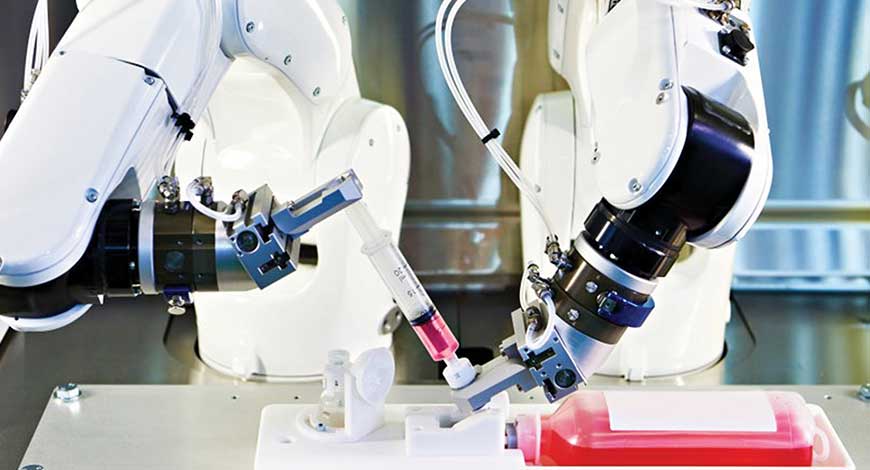MB Stories
Enhancing efficiency and accuracy

Lab automation offering unparalleled efficiency and precision is fostering a future for integration and innovation to go hand in hand.
In the dynamic realm of scientific exploration, lab automation has emerged as a catalyst for transformative change. It combines common research workflows and technologies, such as robotics, computers, and liquid handling instruments. Despite ever-changing needs and techniques, a common thread in lab automation remains constant – lab automation reduces or eliminates manual research tasks, improving experimental efficiency, accessibility, and reproducibility.
The scientist and the machine-symbiotic partnership
Recognizing the dynamic between scientists and automated technologies is the first step. With the help of this mutually beneficial alliance, scientists are able to move beyond ordinary work and explore more complex and imaginative areas of inquiry. Human skill and machine precision work together in harmony to produce the best possible outcomes, emphasizing the delicate balance that needs to be struck. Through this partnership, procedures are streamlined and new directions explored.
Clinical microbiology
The implementation of lab automation in clinical microbiology ushers in a transformative era, responding to the imperative to increase productivity and overcome budget constraints and personnel shortages. Beyond mere efficiency gains, lab automation presents a unique opportunity to overhaul laboratory organization, enhance quality, and reduce turnaround time (TTR).
One of the most relevant innovations of lab automation regards the reading phase, with the possibility to read simultaneously all the plates inoculated from one of even more samples from the same patient. Moreover, taking advantage of informatics, it is also possible to view patient microbiological, hematological, and even clinical and therapeutic data while reading the plates.
A pivotal innovation lies in the reading phase, where lab automation enables simultaneous reading of plates inoculated from multiple samples of the same patient. Leveraging informatics, this patient-oriented approach integrates microbiological, hematological, clinical, and therapeutic data, fostering a clinically meaningful interpretation of results and informed decision-making.Lab automation aligns with lean principles, reducing waste and enhancing efficiency.
Lab automation reduces turnaround time in various diagnostic areas, aided by AI algorithms. Integration with MALDI-TOF MS, molecular diagnostics, and sequencing enhances diagnostics while complementing traditional culture methods.
The innovation of AI in lab automation
 Prof Praveen Sharma
Prof Praveen Sharma
Scientific Consultant,
Snibe Diagnostics
Perhaps the total laboratory automation solutions (TLA) will be the first to come up when we talk about laboratory automation. However, the recent development in artificial intelligence (AI) and machine learning (ML) is poised to significantly impact the industry.
It is well known that TLA systems can help laboratories optimize operations by intelligently integrating analyzers, streamline, and software. It will allow laboratories to perform several of tests automatically, including biochemistry, immunology, electrolyte, and molecular. Additionally, it can more effectively handle growing test volumes, simplify workflows, and cut expenses by automating processes.
And now, the TLA solutions are capable of much more with the power of AI and ML. Today, lab automation is aimed at boosting efficiency in the face of ongoing shortages in skilled laboratory professionals. Now labs are able to leverage AL/ML to automate processes, sort and prioritise samples, distinguish across conditions, validate findings, and carry out quality assurance.
Automatic quality assurance checking
Auto QC continuously reviews patient results to detect deviations from normal or extended ranges. This alerts the lab staff when thresholds are crossed, based on rules and past data, to prevent potential QC problems.
Disease detection and monitoring
With the aid of ML, AI can analyze a vast amount of disease data and predict the progression of the illness by analyzing recent and multiple diagnostics.
Chatting to an assistant
Now, any patient’s diagnostic results can be checked on a PC or phone simply by chatting with the AI. Far away from the laboratory? No worry, just chat with the AI assistant to get the information.
Cloud computing and data handling
Under the capability of cloud computing, all diagnostic data can be aggregated on a visual dashboard, allowing for an intuitive view and retrieval of detailed information for each data. Moreover, the data-handing system can model the diagnostic requirements from the most recent period, forecast the kind and quantity of patients that will visit, assist in making proper purchases of reagent kits and consumables, and cut down on unnecessary costs.
AI and ML can make laboratory even more streamlined. We expect AI will significantly increase the utility of laboratory testing.
Liquid handling and microfluidics unveiled
Microfluidics, a transformative technology, offers precision in managing small volumes, distinguishing itself from its robotic counterparts. Unlike conventional systems, microfluidics stands out for its ability to redefine experimental protocols and enhance cell culture methods.
This innovative approach unlocks unparalleled control over minute liquid volumes, showcasing its potential to revolutionize laboratory workflows. The transformative impact of microfluidics extends beyond conventional liquid handling, ushering in a new era in experimental design and execution. Researchers and scientists can now explore novel protocols and cell culture techniques with enhanced precision and efficiency. The integration of microfluidics into lab automation not only streamlines processes but also opens new avenues for experimentation, paving the way for innovative breakthroughs in various scientific domains.
High-throughput screening
Advanced automated platforms and tools enhance high-throughput screening in molecular discovery and drug development. Technologies like laboratory-on-a-chip and microplate-based systems, with liquid handling robots and scheduling software, enable rapid and reproducible semi-automated or fully automated compound screening. Array-based multi-well formats support diverse high-throughput applications, boosting efficiency in academic and industrial research.
Immunoassays
From arrayed immunoassays to blotting-based techniques, lab automation facilitates faster and more reproducible workflows. For example, antibodies can be robotically arrayed by liquid handlers for multi-well formats, such as enzyme-linked immunosorbent assays (ELISAs) or spotted on membranes with microfluidic technologies, such as soft lithography. These automated technologies help scientists overcome limitations of conventional immunoassay workflows, reducing sample and antibody waste, accelerating analysis times, and increasing multiplexing capability.
Automated reporting and data management
Lab automation tools, like LIS and LIMS, evolved from early devices such as chart recorders. Modern systems use programmable interfaces for bidirectional data transfer between instruments and computers. Advances in computing and AI facilitate remote labs, marking the next generation of accessible research technologies.
IVD industry in 2024
 Karan Bhatia
Karan Bhatia
Head – Marketing (South West Asia,
Beckman Coulter Diagnostics
The in vitro diagnostics (IVD) industry in India is poised for significant growth in 2024, with the increased adoption of new technologies and overall increase expected in testing. The sector is being propelled forward by advancements in artificial intelligence (AI), molecular diagnostics, digital health, regulatory reforms, and government initiatives promoting indigenous manufacturing.
Trends in the diagnostics industry
In terms of overall diagnostic testing, we can anticipate that testing volumes in Tier-III and Tier-IV locations will continue to increase significantly. This will be driven largely by greater awareness and preventive testing. As testing volumes see an increase, the demands on labs for delivering high-quality results will also increase.
For a large number of labs, we will continue to see a transition to more advanced 5-part differential hematology analyzers. Smaller labs will build up their capability to independently deliver reliable immunoassay tests. Labs with higher workloads are also expected to invest in workflow automation. These investments are going to be driven by the demand for a quick turnaround time in test reporting as well as expectations on high-quality, error-free reporting.
Early detection and disease prevention
The evolving healthcare landscape emphasizes proactive health management, with a notable increase in health checks and comprehensive body profiles. Innovations like monocyte distribution width for sepsis management and the prostate health index (phi) for prostate cancer detection will further refine diagnostic precision. Reproductive health screenings are integral to women’s health, fostering early detection and preventive measures. Simultaneously, regulatory initiatives addressing electronic waste, plastic waste, and battery waste underscore the industry’s commitment to sustainable healthcare practices and environmentally conscious future.
Lab of the future
The lab of the future is characterized by higher efficiency and precision, especially in mid- to high-workload laboratories. Total lab automation and clinical IT integration, with sophisticated dashboards fueled by big data, are shaping the future and minimizing errors across the analytical workflow.
As the IVD industry orchestrates a diagnostic revolution, the convergence of technological prowess, regulatory support, and a commitment to patient well-being promises a healthier and more resilient future for all.
Remote labs – biofoundries and cloud labs
Biofoundries and cloud labs enable scientists to conduct automated experiments remotely, eliminating the need for specialized equipment. Biofoundries focus on DNA manipulation, while cloud labs offer centralized automated facilities. Emerging in the US and globally, these solutions enhance lab automation, though challenges like standardization and workforce impact demand careful consideration for responsible integration and innovation in scientific progress.












